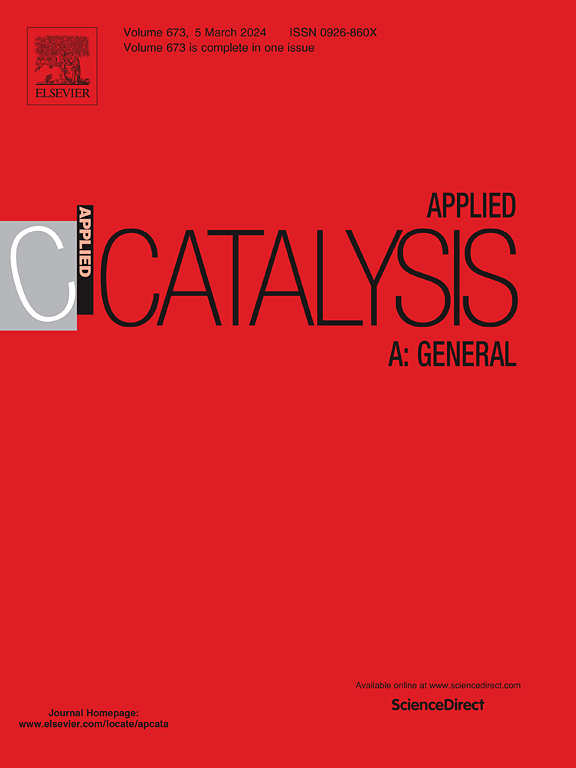FeOx clusters confined in ZSM-5 as a high-performance catalyst for Fischer-Tropsch synthesis of lower hydrocarbons
IF 4.8
2区 化学
Q2 CHEMISTRY, PHYSICAL
引用次数: 0
Abstract
Under the dual pressures of oil depletion and low-carbon transition, Fischer-Tropsch synthesis (FTS) technology offers a viable option for producing high value-added lower (C2-C4) hydrocarbons from non-oil sources. However, conventional Fe-based catalysts often suffer from deactivation due to carbon deposition and sintering. Here, we report a unique Fe-ZSM-5 catalyst synthesized by doping Fe into ZSM-5, which demonstrates excellent FTS catalytic performance. During high-temperature template removal, Fe species migrated from the zeolite framework to form highly dispersed FeOx clusters (∼2 nm). Upon treatment by syngas, these FeOx clusters aggregate to form uniformly small-sized Fe5C2@C core-shell particles distributed on ZSM-5 support. The confinement effect of the inter-crystalline structure effectively prevents the sintering of Fe5C2. The smaller Fe5C2 particles exhibit controlled CO dissociation, reducing the concentration of activated carbon species (C*), and the carbon shells (∼6.5 nm) limit the departure of C*, effectively suppressing carbon deposition. This unique structure enables stable catalytic activity for over 100 hours with maintained product selectivity. The Fe-ZSM-5 catalyst achieved a C2-C4 hydrocarbons selectivity of 54.52 %, nearing the 56 % theoretical limit of the Anderson-Schulz-Flory (ASF) distribution. Additionally, the hydrophobic carbon shell prevents excessive oxidation of Fe5C2, reducing CO2 selectivity by ∼56 % compared to conventional Fe/ZSM-5 catalysts, significantly enhancing atomic utilization efficiency and aligning with the principles of green development.
限定在ZSM-5中的FeOx簇作为费托合成低碳氢化合物的高性能催化剂
在石油枯竭和低碳转型的双重压力下,费托合成(FTS)技术为从非石油来源生产高附加值的低碳氢化合物(C2-C4)提供了一个可行的选择。然而,传统的铁基催化剂经常因碳沉积和烧结而失活。本文报道了一种独特的Fe-ZSM-5催化剂,该催化剂在ZSM-5中掺杂Fe,具有优异的FTS催化性能。在高温模板去除过程中,Fe物种从沸石框架迁移形成高度分散的FeOx团簇(~ 2 nm)。经合成气处理后,这些FeOx团簇聚集形成均匀的小尺寸Fe5C2@C核壳颗粒,分布在ZSM-5载体上。晶间结构的约束效应有效地阻止了Fe5C2的烧结。较小的Fe5C2颗粒表现出可控的CO解离,降低了活性炭种类(C*)的浓度,并且碳壳(~ 6.5 nm)限制了C*的离开,有效地抑制了碳沉积。这种独特的结构使催化活性稳定超过100 小时,保持产物选择性。Fe-ZSM-5催化剂对C2-C4烃的选择性达到54.52 %,接近Anderson-Schulz-Flory (ASF)分布的理论极限56 %。此外,疏水碳壳防止了Fe5C2的过度氧化,与传统的Fe/ZSM-5催化剂相比,二氧化碳选择性降低了~ 56 %,显著提高了原子利用效率,符合绿色发展原则。
本文章由计算机程序翻译,如有差异,请以英文原文为准。
求助全文
约1分钟内获得全文
求助全文
来源期刊

Applied Catalysis A: General
化学-环境科学
CiteScore
9.00
自引率
5.50%
发文量
415
审稿时长
24 days
期刊介绍:
Applied Catalysis A: General publishes original papers on all aspects of catalysis of basic and practical interest to chemical scientists in both industrial and academic fields, with an emphasis onnew understanding of catalysts and catalytic reactions, new catalytic materials, new techniques, and new processes, especially those that have potential practical implications.
Papers that report results of a thorough study or optimization of systems or processes that are well understood, widely studied, or minor variations of known ones are discouraged. Authors should include statements in a separate section "Justification for Publication" of how the manuscript fits the scope of the journal in the cover letter to the editors. Submissions without such justification will be rejected without review.
 求助内容:
求助内容: 应助结果提醒方式:
应助结果提醒方式:


